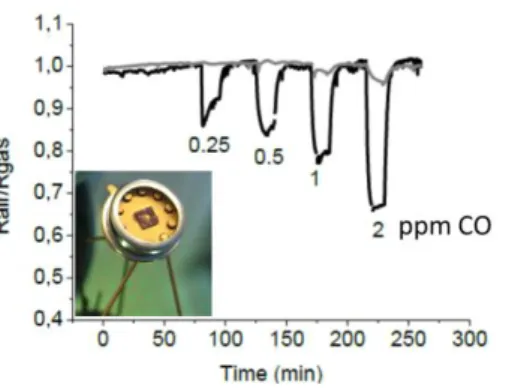HAL Id: hal-02048850
https://hal.archives-ouvertes.fr/hal-02048850
Submitted on 25 Feb 2019
HAL is a multi-disciplinary open access
archive for the deposit and dissemination of
sci-entific research documents, whether they are
pub-lished or not. The documents may come from
teaching and research institutions in France or
abroad, or from public or private research centers.
L’archive ouverte pluridisciplinaire HAL, est
destinée au dépôt et à la diffusion de documents
scientifiques de niveau recherche, publiés ou non,
émanant des établissements d’enseignement et de
recherche français ou étrangers, des laboratoires
publics ou privés.
Self-Assembled Hollow SnO2 Octahedra for sub-ppm
Gas Detection Sensors
Justyna Jońca, Andrey Ryzhikov, Myrtil L. Kahn, Katia Fajerwerg, Audrey
Chapelle, Philippe Menini, Pierre Fau
To cite this version:
Justyna Jońca, Andrey Ryzhikov, Myrtil L. Kahn, Katia Fajerwerg, Audrey Chapelle, et al..
Self-Assembled Hollow SnO2 Octahedra for sub-ppm Gas Detection Sensors. Trends in Nanotechnology
International Conference (TNT2015), Sep 2015, Toulouse, France. �hal-02048850�
Self-Assembled HollowSnO2 Octahedra for sub-ppm Gas Detection Sensors
Justyna Jońca1, Andrey Ryzhikov1, Myrtil L. Kahn1, Katia Fajerwerg1,2, Audrey Chapelle3, Philippe Menini3, Pierre Fau1,2
1 Laboratoire de Chimie de Coordination (LCC), CNRS, 205 route de Narbonne, 31077 Toulouse Cedex 4, France
2 Université Paul Sabatier, UT III, 118 route de Narbonne, 31062 Toulouse Cedex 9, France
3 Laboratoire d’Analyse et d’Architecture des Systèmes (LAAS), CNRS, 5 avenue du Colonel Roche, 31400 Toulouse, France
e-mail: pierre.fau@lcc-toulouse.fr, myrtil.kahn@lcc-toulouse.fr
Abstract
Nanostructures of SnO2 including nanoparticles,1 nanowires,2 nanobelts,3 and nanotubes 4have been
widely used in many fields, such as gas sensors, solar cells and lithium batteries.Recently, hierarchical and/or hollow SnO2 micro- and nanostructures have attracted much interest because of their
widespread potential applications such as gas sensors.5 We present here the formation of
self-assembled tin oxohydroxide (Sn3O2(OH)2) supercrystals organized in a “Russian-doll” structures and
obtained by an organometallic synthesis, with finely tuned water addition. These supercrystals have been characterized by transmission and high resolution transmission electron microscopy, field-emission scanning electron microscopy, X-ray powder diffraction, and Fourier transform infra-red spectroscopy. These super-octahedra have been used as gas sensitive layers deposited on silicon devices. After in-situ heating, Sn3O2(OH)2 easily oxidizes into SnO2 while retaining the initial morphology
and porosity (fig.1) . The response of the sensors to reducing and oxidizing gases has been measured at relative humidity (RH) of 50%. At 500°C and under very low CO concentrations (0.25 to 20 ppm), the sensors present an outstanding dynamic response (7% and 67% of resistance variation) (Fig. 2). A response of 196% is obtained under 1 ppm NO2 at an operating temperature of 300°C. These
unprecedented detection performances are strongly relied to the hierarchical microstructure of SnO2
supercrystals. These sensitive layers open the way to the development of metal oxide devices dedicated to extremely low gas concentration determination.
Figures
Fig: 1: hollow SnO2 self-assembled octahedra Fig. 2: sub-ppm detection capability for SnO2
octahedra sensitive layer
References
1 C. Nayral, E. Viala, P. Fau, F. Senocq, J.-C. Jumas, A. Maisonnat, B. Chaudret, Chemistry, Eur. J.
2000, 6, 4082.
2 M.-S. Park, G.-X. Wang, Y.-M. Kang, D. Wexler, S.-X. Dou, H.-K. Liu, Angew. Chem. 2007, 46, 750. 3 E. R. Viana, J. C. Gonzalez, G. M. Ribeiro, A. G. de Oliveira, J. Phys. Chem. C 2013, 117 (15), 7844. 4 L. Shi, H. Lin, Langmuir 2011, 27, 3977 ; J. Ye, H. Zhang, R. Yang, X. Li, L. Qi, small 2010, 6, 296. 5 H. Wang, A. L. Rogach, Chem. Mater., 2014, 26, 123
